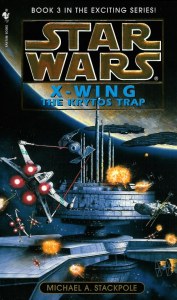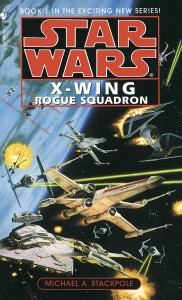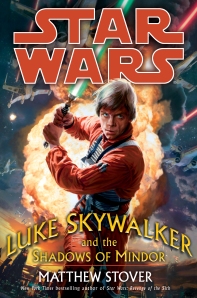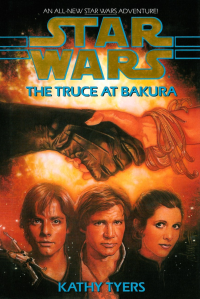Just a hair over two weeks this time! Maybe I’ll shoot for one week for the next one…
While The Krytos Trap is mostly more of the same, Stackpole has upped his game from the first two entries in the series. As with my review of Wedge’s Gamble, this review will contain major spoilers for the first two books in this series. Read on at your own risk.
As The Krytos Trap begins, the Alliance has taken Coruscant – or, to be more precise, Ysanne Isard has given Coruscant to the Alliance. Before relinquishing control of the world, however, Isard commissioned the creation of the titular Krytos virus, a horrifying, highly contagious disease that only affects certain species, humans being one of the groups spared. This virus, while curable, has the potential to simultaneously bankrupt the Alliance while severely limiting the supply of life-saving bacta, and destroy confidence in the Alliance’s ability to keep its new citizens safe.
Meanwhile, Wedge, Mirax, and the rest of Rogue Squadron mourns the death of Corran Horn, while the Provisional Council brings murder and treason charges against Tycho Celchu for Horn’s murder and for supplying Isard with classified intelligence from within the squadron. Wedge, convinced of Tycho’s innocence in the matter, searches tirelessly for Corran’s murderer and the traitor he knows remains hidden within the Rogues’ ranks.
But unbeknownst to the Alliance, Corran did not die during the liberation of Coruscant. Rather, he was taken captive by Ysanne Isard and brought to her feared Lusankya prison facility to be converted into a weapon against the Rebellion. Corran resists his torture as best he can while planning his escape from a prison no one has ever escaped from – and of which no one, Corran included, knows the location.
This book could have easily gone by one of two different titles – Escape from Lusankya or The Trial of Tycho Celchu. The majority of the book, in fact, focuses on Tycho’s trial and the investigations to prove either Tycho’s guilt or innocence. A smaller portion focuses on Corran’s torture and attempts at escape in Lusankya, while a yet smaller portion focuses on the politics between the new Republic’s Provisional Council, the bacta cartels on Thyferra, and a small, almost-insignificant detour to Ryloth. In fact, there may be even less X-Wing action in this book than there was in Wedge’s Gamble.
Yet, somehow, all of this is more compelling than most of the first two books in the series. In fact, the entire second half of The Krytos Trap – which comprises the final stages of Tycho’s trial, Corran’s escape attempts, and Kirtan Loor (remember him?) desperately trying to get out from under the various thumbs that rule him – is the most engaging, exciting part of the series thus far. It seems Stackpole is at his best when he’s not stuck using the overly-technical descriptions of X-Wing and TIE fighter flight that dominate the space and air battles of the series.
That’s not to say The Krytos Trap is free of the flaws I’ve noticed in Stackpole’s previous entries. He still has the very frustrating tendency to skip over scenes I want to read about – a certain rather major reunion in the latter half of the book is almost entirely skipped over, with the next chapter taking place over a week after said reunion, leaving the reader in the awkward position of being told what happened after the fact rather than reading how it happened in the moment. This has been an issue with Stackpole throughout the series, but it seems pretty glaring in this one once things really start rolling later in the book.
Thankfully, some characters are fleshed out more than they have been in the past. Iella Wessiri in particular (Corran’s former Corellian Security partner) has more to do this time, leading the investigation into Corran’s apparent death. We learn that she has a husband who has just been recovered from Imperial custody – a revelation that could have felt forced, but instead allowed the reader a bit more of an insight into Iella’s state of mind. I anticipate further development of her character throughout the rest of the series if the ending of The Krytos Trap is any indication.
Nawarra Ven, the Twi’lek attorney-turned-fighter-pilot, also gets to shine in this book as Tycho’s defense attorney. While the courtroom scenes that dominate the book could have been insufferably boring quite easily, it’s largely due to Nawarra’s spirited defense and steadfast faith in his client that these scenes are actually a highlight of the novel. Seeing Nawarra in his element for the first time (and getting a few chapters told from his point of view) brings him up from a less-than-interesting background character to an important part of the squadron’s story. While the short detour to his home planet of Ryloth was largely unnecessary to the plot of this book (though I admit it may have consequences for future entries in the series), the journey did allow for even more development for his character.
Gavin Darklighter and newcomer Asyr Sei’lar (introduced in the previous book trying to kill Gavin), now a couple, get some more development as well. Asyr’s allegiances, as a Bothan, are torn between her people (personified in the power-hungry Councilor Borsk Fey’lya) and Rogue Squadron. While this subplot could have felt forced, having Gavin – who she obviously has true feelings for – as a window into her world helps to ground her story in something familiar. There’s a great scene where Gavin and Asyr attend a Bothan party together, and Gavin stands his ground against another Bothan without fighting back that speaks to how much Gavin has evolved as a character from his Biggs-surrogate origins (though, as Stackpole tends to do, this point is hammered home a little to unambiguously for my taste).
Kirtan Loor, on the other hand, suffers in this book. While his stature improved in Wedge’s Gamble, in this entry he manages to have freedom to act on his own authority without Isard’s direct instructions, only to find himself under the control of Colonel Fliry Vorru, former Imperial agent turned crime lord turned Alliance agent who clearly wants nothing more than as much power as he can get. Having Loor broken down the way he is in this book does his character’s potential a disservice – where once there was a legitimate Vader/Tarkin surrogate hunting the Rogues, Loor is now little more than a Piett or Jerjerrod surrogate. Of course, I’d prefer Loor to be his own character to either of those things, but a Vader/Tarkin figure is better than a Piett/Jerjerrod figure.
Honestly, I don’t have much more to say about this one. It suffers from many of the same flaws as the first two books in the series, but improves enough to be much more engaging than either of the first two. There are also many more hints of things to come, and while the story has more of a final ending than the second entry in the series did, it also does a lot to set up what comes next. There’s a surprise cameo toward the end that I won’t spoil, and more hints (some more direct than others) toward Corran’s possible future in the books to come.
While this series hasn’t been perfect, or quite as good as Shadows of Mindor, it’s still some fantastic Star Wars that expands the universe beyond the Jedi-Sith conflict while still feeling like the same story, and with The Krytos Trap, it has elevated itself beyond “Pretty good” to “Pretty much essential.”
I’m definitely looking forward to jumping into The Bacta War.
X-Wing: The Krytos Trap: EXCELLENT




